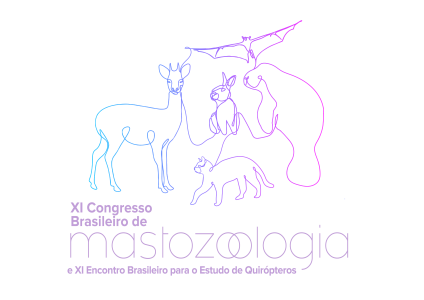Dados do Trabalho
Título:
Description of the first three antler cycles in captive marsh deer (Blastocerus dichotomus)
Resumo:
In the Cervidae family, antlers are a secondary sexual characteristic that is presented in males of most species. These bony structures are renewed periodically, showing a fast growth with velvet coverage until it dries and is shedded off and the hard antlers appear completely. In temperate climate cervids, antler casting is seasonal and synchronous between individuals, due to the influence of photoperiod on testosterone levels. However, in Neotropical species, as marsh deer (Blastocerus dichotomus), this periodicity is little understood, since there is no marked breed season and factors such as stress and nutrition may be related. Previous studies suggests that, in this species, antler casting has an individual frequency and it is related to age, with adult animals retaining their antlers longer. Thus, the present study aimed to analyze the antler cycle in captive marsh deer. For this purpose, 19 males (4.90 ± 2.07 years old) were observed weekly, from the appearance of the first button until the cast of the first three antlers. The stages were classified as: A) growth (from button to velvet shedding) and B) retention period (from hard antlers to casting), totaling six consecutive stages. The means and standard deviation of stages A and B for the first antlers were 7.1 ± 1.45 and 6.0 ± 3.5 months, respectively; for second antlers were 3.31 ± 0.58 and 17.55 ± 16 months; and for third antlers were 3.9 ± 0.91 and 37.25 ± 16.64 months. Simple linear regression model was tested for stages A and B separately, and both were significant (p<0.05). In the model for stages A, the data showed a negative relationship, in which the mean time to growth period decreased in relation to age, with a coefficient of determination of the model r2= 0.40. For stages B, the age had a positive relationship with the retention period, with a model value r2= 0.46. It is observed that the standard deviation of growth periods (A) was less variable than the retention periods (B). At stage B of the second antlers, there was great variation in the retention period: in 12 animals, the period was less than 20 months, while three animals showed 35, 38 and 69 months. At stage B of the third antlers, most animals showed less than 40 months of retention, while two individuals retained their antlers for 70 months. In the literature, there are only two reports of antler retention for more than 32 months, involving free-ranging marsh deer, whereas in the present study we observed 10 captive animals which retention periods were longer than the mentioned. Therefore, the results showed that, in this species, there are no seasonal cycles of antler casting but that the time of retention is related to the age of the animal, that is the retention period duration is individual and increases as the animals get older. Further studies on the relationship of nutrition and pathologies with antler casting may point associations between these aspects.
Keywords: marsh deer, antler cycle, neotropical deer, Cervidae
Financiamento:
Área
Fisiologia
Autores
Laís Jaqueline de Souza, Thaylane Paula Financi, Valdir Nogueira Neto, Liss Maryori García Moreno, Eveline dos Santos Zanetti, José Maurício Barbanti Duarte
